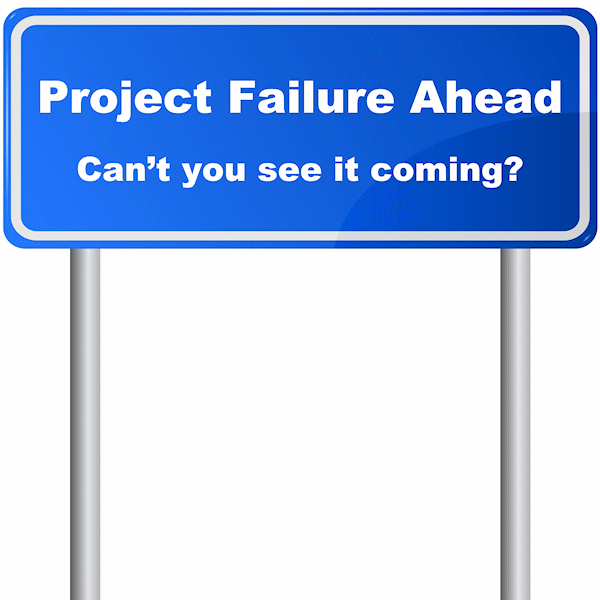By Chris Stone, Project Manager for Rocky Mountain Trade Adjustment Assistance Center
Success or Failure
The success or failure of an individual project is not always clear.
Complete success or total failure are readily understood. Most projects, however, fall somewhere on the continuum of partial success or partial failure.
From a project management perspective, project success is formally defined as completing project requirements within the triple constraints of time, cost, and scope.
Thus, strictly speaking, project failure is not meeting a project’s requirements within these constraints. However, such a narrow definition of project failure does not provide a complete understanding of the qualitative health of the project and whether, or not, it can be considered successful.

History Lesson
The formal definitions of project success and failure go back to the early days of project management, with the U.S. Department of Defense (DOD.)
Having to manage thousands of contractors, the DOD needed to standardize project performance reporting. The result was the earned value measurement system (EVMS.) For EVMS to be effective, metrics had to be developed to track project performance and measure project success. At the time, the understanding of metrics was relatively unsophisticated and this resulted in adopting metrics which were easy to measure. The two easy measurements of time and cost became the focus of the EVMS.
Over time, DOD contracts with the aerospace and defense industry became increasingly performance based. The engineers leading the projects focused on scope and technical achievements rather than time or cost. As long as DOD would pay for cost overruns and schedule slippages, project success could be measured in terms of technical performance. Cost overruns could exceed several hundred percent. To make matters worse, many engineers viewed “project success” as the ability to exceed, rather than just meet specifications. The DOD paid for the cost overruns.
This brief outline of how project success has historically been measured shows how evaluating a project’s success requires balancing numerous factors. Project success can be defined in different ways, as the constraints are not equally important. For some projects, the focus may be on cost; for other projects meeting a tight delivery date is critical.
Success Evolves
It eventually became clear how the DOD framework for evaluating project success, using the primary constraints of time, cost, and scope, was insufficient. Other constraints were often more important than time, cost, and scope.
These “other” constraints were referred to as secondary constraints and include factors such as:
- Financial success
- Technical superiority
- Competitive advantage
- Strategic objectives
- Environmental standards
- Corporate reputation
- Opportunities for employee advancement
Given the framework of primary and secondary constraints, companies still placed more weight on the traditional triple constraints of time, cost and scope as the primary means for defining success.
The impact of secondary constraints was addressed by analyzing the effect they had on the primary constraints. It was most important to know how secondary constraints increased or decreased any of the primary constraints. For example, developing technical superiority will generally result in increased costs and time. Surprising, to some, is how addressing environmental standards will actually reduce the total landed cost of many projects.

Signs of Project Failure
Management experts have outlined some insights relating to project failure:
- There is no clear and simple definition of project failure
- The line between success and failure is not always clear – it’s a grey area
- There is no “magic bullet” to guarantee success or prevent failure
- A project can be considered a failure even with the successful execution of a project plan
- It is possible to have R&D success and market failure – “success” and “failure” in the same project
- The most reliable IT systems will eventually fail during implementation – it’s just a matter of time for the bugs to appear
Somewhat depressingly, the list of reasons why projects fail is quite long. One assessment identified 46 possible reasons for project failure. Unfortunately, most project managers do not recognize the early symptoms of failure or disregard these symptoms when they begin to appear. Even if they do recognize the symptoms, they often do not know what actions to take.
All too often, a combination of small and insignificant things add up – the old straw which broke the camel’s back

Three Examples
Let’s examine a few well-known business cases to illustrate this multi-causal approach to understanding project failure.
The cases are:
- Infamous and well-known – to the displeasure of those involved
- Illustrative and (mostly) long forgotten – how not to introduce a new product
- Significant and still evolving – the final analysis, total cost, and lasting damage have not yet been determined

1. Infamous and Well-known
“How does one turn a $1.2 billion project into a $5.0 billion project? It’s easy. Just build a new airport in Denver.”
– Harold Kerzner, PhD in Project Management Case Studies
Pull The Plug
Dysfunctional decision making is the poison that kills technology projects. The DIA Baggage System project is a classic example.
In its simplest form, the DIA project failed because those making key decisions underestimated the complexity involved. After spending close to $5 billion, over 14 years, to get the automated baggage handling system to work, DIA officials finally pulled the plug on the project in August 2005.
Background
Denver International Airport (DIA), was approved by City of Denver officials in 1985 to replace Stapleton International Airport. The initial budget was $1.2 billion. The business case was solid. Denver needed the new airport to handle the projected volume of more than 66 million passengers per year. In 1989, voters approved the project as estimated cost grew to $1.7 billion. Construction of the airport began in November 1989.
More trouble occurred, while working through the details of a lease agreement, with United Airlines. The decision makers from the City of Denver Project Management Team did not fully understand the complexity of the scope changes United demanded. The parties eventually reached agreement in June 1991.
In October 1990, Breier Neidle Patrone, was hired to evaluate one of the scope changes – an automated baggage-handling system to be used only for the United Airlines concourse. Patrone concluded the request, by United Airlines, was not feasible. Rather than accept the assessment, the DIA Project Team decided to double down and expand the scope of the automated baggage-handling system to cover the entire airport!
In early 1992, BAE Systems was selected to design and build the baggage handling system. As planned, the system would be the most complex baggage system ever attempted. The airport had already been under constructions for three years. BAE agreed to do eight years of work, in just two years, to meet the October 1993 opening date.
Promising the moon in two years did not go well. Problems with the baggage system causes the airport’s opening to be delayed by 16 months. Expenditures to maintain the empty airport, and interest on the construction bonds, cost the city of Denver $1.1 million per day during the delay.
Along the way, there was disastrous impromptu demonstration of the system to the media – the amazing system crushed bags, disgorged content, and crashed carts together at high speeds. DIA was widely ridiculed. Many mocked the project, claiming “DIA” stood for “Delayed Indefinitely Again,” “Debacle in Aviation,” and “Denver’s Ignominious Atrocity.”
DIA finally opened on February 28, 1995 – with a manual trolley-based baggage handling system.

Conclusion
The DIA debacle can serve as a template for failure as seen in many other projects.
Factors which contributed to the failure include:
- Underestimation of complexity
- Lack of planning resulting in subsequent changes in strategy
- Excessive schedule pressure
- Lack of due diligence
- Making firm commitments in the face of massive risks and uncertainty
- Poor stakeholder management
While these points all contributed to the failure, poor decision making was the primary problem which triggered the fiasco. Successful projects require leaders with knowledge and experience which enables them to make effective decisions.
The people from DIA’s project team and BAE’s managers lacked the necessary experience for developing a system of this scale. As automated baggage systems were relatively new, BAE’s senior management team had a limited understanding of what was involved. This lack of knowledge, combined with the fact that expert advice was routinely ignored, is at the core of this failure.
Project Risk Factors
An assessment of the project, based upon five project failure risk factors, suggests:
- Leadership Capabilities – very poor
- Technological Risk – very high
- Stakeholder Management – very poor
- Project Management – very poor
- Business Case Risk – low
2. Illustrative and (mostly) Long Forgotten
“We’re a classic MBA case study in how not to introduce a product.
First, we created a marvelous technological achievement. Then we asked how to make money on it.”
– John Richardson, CEO, Iridium
Where’s The Exit Ramp?
The longer the project, the greater the need for project sponsors to make sure the business plan has “exit ramps” so the project can be terminated before massive resources are committed and consumed. Unfortunately, when a strong collective belief exists, exit ramps are purposefully not included in the project plan. In the end, nobody was willing to pull the plug on Iridium.
Background
The Iridium Project was conceived in late 1987 and used a network of 77 satellites. The “Iridium” name was derived from the element Iridium, AKA atomic number 77. The vision was to create a worldwide wireless mobile phone system which could communicate anywhere in the world at any time. Executives at both Motorola and Iridium regarded the project as the technological “eighth wonder of the world.”
Iridium did extensive market research. Breakeven was set at 600,000 global customers. Late in the project build-out, the pay-back period was calculated at one year. By late 1997, Iridium was burning $100 million per month. A July 1997 IPO raised $360 million by projecting 5 million users by 2002.
In 1998, the Iridium system launched. From a project management perspective, it was a success. The 11-year project was completed just one month behind schedule. Total investment was nearly $5 billion. Analysts issued a “buy” recommendation for the stock and projected revenues of $5 billion within 5 years.
Unfortunately, Iridium was a success and a failure at the same time. As a successful project, it was completed essentially on time and created intellectual property of more than 1,000 patents. As a failure, investors lost more than $4 billion because the marketplace for the product had changed significantly over the life of the project.
In hindsight, it appears project progress was measured solely by technical performance and remaining on schedule. Had executives developed a more complete definition of success, one which included customer value, it is likely the project would have been cancelled well before billions of dollars were wasted.
One challenge with customer acceptance was the phone itself – customers balked at the price of the $3,400. That was just the start: “It’s huge! It scares people. It is like a brick with an antenna like a stout bread stick.” – John Windolph, Iridium Director of Marketing Communications.
The phones, weighing in at about a pound, required special training and a bag of attachments. They could not be demonstrated to potential customers, as numerous technical issues were still being solved. Marketing wisely avoided discussion of the phone, focusing instead on the fear of “being out of touch.”
A second challenge came from the 15 worldwide “gateway partners” responsible for distribution in their respective countries. Many had failed to create marketing plans, build sales teams, or set up distribution channels. Some partners lacked telecom experience, such as the Venezuelan partner who was also in the dairy products business. The phones, weighing in at about a pound, required special training along with a bag of attachments.
Iridium’s advertising campaign “Calling Planet Earth” promised the freedom to communicate anytime, anywhere. This was not exactly true! The phones did not work inside buildings or cars. Ads in publications worldwide attracted lots of attention and generated more than one million sales inquiries, which were then forwarded to the gateway partners. The partners, having failed to set up sales organizations, were unable to respond to the hot leads, which soon became cold.

By August of 1999, just 9 months after launching, Iridium filed for bankruptcy protection. Iridium had only 20,000 customers and was generating revenue of $1.5 million per month. Pricing was at $7 per minute. Competitors were already offering similar service for as low as 10 cents per minute!
Conclusion
Iridium’s technology was envisioned to be the holy grail of telecommunications. Unfortunately, the need for the technology Iridium developed changed over the project’s 11 year build out. Cheaper and better options became available. The engineers who designed Iridium, many of whom had a background with military projects, lacked an understanding of competitive markets and the necessity to create an extensive marketing operation to sell the service their impressive technology provided.
Failure can result from a poor business case or from project leaders failing to recognize (or not be willing to recognize) the economics of the case has changed. To manage risk, project managers should:
- Work with the client and the stakeholders to clearly define the business case
- Set up a timetable for periodic review of the business case
- Establish metrics for tracking the assumptions in the business case
- Determine how changes in assumptions will impact the viability of the project
- Conduct ongoing evaluation of whether to continue investment or hit the exit ramp
Project Risk Factors
An assessment of the project, based upon five project failure risk factors, suggests:
- Leadership Capabilities – good
- Technological Risk – high
- Stakeholder Management – very poor
- Project Management – good
- Business Case Risk – very high
3. Significant and Still Evolving
“This airplane is designed by clowns, who in turn are supervised by monkeys.”
– Boeing Test Pilot discussing the 737 MAX-8
Something’s Wrong
Boeing decided to modify the 50-year-old 737, rather than develop a “clean sheet” passenger jet to serve the short-haul high-volume air transport market. Two 737 MAX crashes, in late 2018 and early 2019, quickly grounded the fleet worldwide and brought Boeing’s engineering capabilities and its management’s competence under intense scrutiny.
The factors which contributed to this disaster are complex and interrelated. Boeing made a series of (now) questionable decisions. The full extent of the damage and total costs will not be known for many years.
On January 29, 2020, Boeing doubled the projected cost of the 737 MAX crisis, adding $9.2 billion, bringing the total cost to $18.4 billion. Boeing’s full year 2019 net loss of $636 million is its worst financial result in more than 20 years. One analyst deemed this a “Kitchen Sink quarter,” suggesting that new Boeing CEO Dave Calhoun was dumping all the company’s negative news into the 4th quarter of 2019. Based on what seems to be never-ending bad news coming out about the 737 MAX, these financial losses are likely to be just a small part of the damage done to the US aerospace giant.
This could be the largest financial disaster in history.

Background
Throughout 2019, first the press and then Federal Aviation Authority (FAA) officials investigated how the 737 went from Boeing’s “cash cow,” its most successful and profitable plane ever, to becoming a threat its financial viability. A complex narrative has emerged which goes back more than 50 years.
In 1964, Boeing developed the 737 to meet the detailed specifications of Lufthansa managing director Gerhard Holtje, who needed a 100-seat jet for European intercity routes. Boeing’s intercontinental 707 and shorter-range 727 had been very successful for Lufthansa. The 737 rounded out Boeing’s product family and allowed Lufthansa to have an all-Boeing fleet. This “fleet commonality” as it’s called, saves on pilot training and maintenance costs. The 737 also shared many components, including the cockpit layout, with the existing planes, which benefited both Boeing and its customers.
The 737 “version 1.0” first flew in 1968 and was a disappointment. It failed to meet Lufthansa’s specifications and was considered a dog. Only 30 were built. The 737 “version 2.0” was ordered by United Airlines and benefited from extensive troubleshooting and improved engines. By 1981, 737 “version 3.0” had finally found the sweet spot in the market. This version was perfect for the high-volume intercity routes which enabled budget airlines, around the world, to expand the market for air travel. Boeing sold more than 10,000 737s – the plane was a “money making machine.”
For decades, Boeing’s strategy of iteration and improvement of the 737 was both successful and very profitable. However, the crashes of Indonesia’s Lion Air Flight 610 on October 29, 2018 and Ethiopian Airlines Flight 302 on March 10, 2019, changed everything. With the loss of all 346 passengers aboard the two flights, the long running of success of the 737 ended abruptly. The plane was grounded worldwide as of March 18, 2019. As of early 2020, it remains grounded.
Factors contributing to the 737 MAX disaster, are complex, interrelated, and consist of both external aerospace industry factors as well as internal Boeing policies and decisions.
Policies and Decisions
- The 737 airframe is 50 years old. The design could not accommodate larger modern engines, as the wings were too close to the ground. The 737 is an analog plane in a digital world.
- In 1997, Boeing merged with competitor McDonnell Douglas. Boeing’s engineering culture was gradually overwhelmed by the accounting “bean counter” culture of McDonnell Douglas. Boeing become increasingly focused on costs and short-term stock price rather than “performance at any cost” engineering excellence.
- In 2001, Boeing moved its headquarters from Seattle to Chicago. Accountants began a program of outsourcing to lower cost vendors around the world.
- In 2006, Boeing considered a “clean-sheet” aircraft to replace the 737. The accountants delayed a decision – costs were a significant concern.
- In 2010, Airbus launched the A320neo, a modern more fuel-efficient competitor to the 737. It quickly gained 1,029 orders, a record for a new commercial airliner. In July 2011, American Airlines ordered 260 A320s, breaking Boeing’s monopoly as a supplier to American.
- In August 2011, Boeing decided to re-engine the 737 in response to the A320 success. The updated 737, branded the 737 MAX, would match the A320 for efficiency and performance. This re-engined approach would cost $4 billion, compared to $10-12 billion for a clean sheet design. However, the bigger more efficient engines affected the plane’s flight characteristics, resulting in a tendency to stall under certain conditions.
- The Maneuvering Characteristics Augmentation System (MCAS) was developed to mitigate the stalling “pitch-up” tendency of the 737 MAX. The plane’s new flight geometry resulted from the engines being located further forward and higher than previous engines. The MCAS would automatically push the plane’s nose down, under specific “low speed, high angle of attack” flight conditions. The MCAS relied on input from a single Angle of Attack (AoA) sensor, making it vulnerable to erroneous input from the sensor. Usually such systems have multiple sensors. A malfunctioning single AoA sensor is the likely cause of the Ethiopian Air crash in March 2019. One sensor was cheaper than multiple sensors.
- Large portions of the safety certification process for the 737 MAX were delegated to Boeing by the FAA. FAA technical staff felt pressured by Boeing managers to sign off on the certification.
- To reduce training costs, Boeing pushed to have the 737 MAX classified as essentially the same plane as the previous version. MCAS was downplayed in importance and was not included in the pilot manual. As a result, pilots were not familiar with the system. Inexperienced pilots did not know how to properly respond to its activation. FAA and Congressional investigations also learned how flight simulators did not accurately represent the functioning of MCAS. In actual flight, pilots had less than 10 seconds to respond to MCAS to prevent a rapid descent.
- Congressional investigators found Boeing CEO Dennis Muilenburg’s answers to questions “were consistent with a culture of concealment and opaqueness and reflected the immense pressure exerted on Boeing employees during the development and production of the 737 Max.” In December 2019, Boeing CEO Dennis Muilenburg resigned.
- In September 2019, aerospace industry analyst Richard Aboulafia wrote that Boeing’s “communications with Congress, the FAA, international regulators, airline customers, suppliers, the victims’ families, and pretty much the entire outside world were a master class in bad crisis management.”
- In January 2020, Aboulafia continued: “It’s no longer about MCAS. It’s about things that might be discovered. This is going to be the most scrutinized certification in history.”
- Since 2013, Boeing spent $43.4 billion to buy back its own shares in order to boost its stock price. In January 2020, it sought more than $10 billion in new funding via a loan from a consortium of banks, on top of the $9.5 billion line of credit it obtained in October 2019. The funding is needed due to the cash flow problems related to the 737 MAX being grounded. Boeing cannot deliver an estimated 400 completed planes until the reasons for the plane being grounded are addressed.
- A Boeing press release on January 21, 2020 states, “We are informing our customers and suppliers that we are currently estimating that the ungrounding of the 737 MAX will begin during mid-2020.”
With COVID-19, there is no believable time estimate for the 737 MAX.
Project Risk Factors
An assessment of the project, based upon five project failure risk factors, suggests:
- Leadership – very poor
- Technological Risk – high
- Stakeholder Management – poor
- Project Management – poor
- Business Case Risk – very high
“The 737 MAX is a damaged brand. I think that word MAX should go down in the history books as a bad name for an aircraft.”
– Steven Udvar-Hazy, Executive Chairman of Air Lease, which has 150 units of the 737 MAX on order
About Chris Stone

Chris is a Project Manager with The Rocky Mountain Trade Adjustment Assistance Center (RMTAAC) in Boulder, where he helps small U.S. manufacturers improve their competitiveness versus import competition. RMTAAC is a federally funded (U.S. Department of Commerce) program that is managed through the University of Colorado, Leeds School of Business.
Over the course of his 18 years at RMTAAC, Chris has helped turn around more than 100 manufacturers across a wide range of industries in the Rocky Mountain Region.
“With my client companies, I like to focus on what is realistic and “do-able,” given a company’s background, experience, and capabilities. Oftentimes, small companies simply don’t know how or where to get started with change. They lack a vision. I view my role as a facilitator and guide, like a business coach, helping companies get moving with key projects, starting small and building upon successes. As companies get comfortable with change and start to see results, they gain confidence and are then able to refine and clarify their vision for the future.”
Chris has worked in manufacturing for more nearly 30 years, beginning in the quality control department of a Colorado Hi-Tech manufacturer. His educational background includes a BA in Economic History, focusing on regional economic development, as well as an MBA from The Leeds School of Business at The University of Colorado.
Beyond the world of work, Chris is an avid sportsman. He likes to keep fit playing tennis, mostly against his daughter and son, along with the occasional mixed doubles with the wife versus the kids, who, these days, generally win.
See: LinkedIn profile
Project Closure
Dysfunctional Teams
Six Sigma Control Plan
Project Champion Guidelines
Team Effectiveness Assessment
Subscribe to our newsletter
References
Denver’s Automated Baggage System from MSNBC
Organizational Improvement Acronyms by Transformance Advisors
Organizational Improvement Definitions by Transformance Advisors
